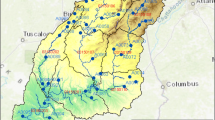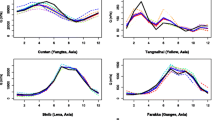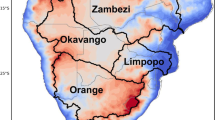Abstract
Water managers are faced with a changing climate in the decision-making process while adaptation and mitigation strategies need to be developed. The climate change impact towards the end of the century, however, is highly uncertain and coping with this is a great challenge for decision makers. Over the recent years, combined efforts of hydrologists and climatologists have led to many climate change impact studies on water resources. However, most studies only use a limited ensemble size and/or focus on only one contributing source and hence possibly underestimate the total uncertainty.
For two Belgian catchments, we simulated daily flow with five different lumped conceptual hydrological models and ten different parameter sets each, forced by the output of 24 global climate models covering four different emission scenarios, combined with 9 different downscaling methods over reference (1961–1990) and future (2071–2100) periods, resulting in a large multi-model ensemble with 41,850 members. Results show that both low and peak flows would become more extreme in the future, and these changes are stronger with increased radiative forcing. The most important uncertainty sources in low-flow projections are the global climate models (explaining 27–36% of the total variance) and the hydrological model structure (34–42%). For peak flow projections, these are global climate models (32–39%) and statistical downscaling methods (21–26%). Also, interaction effects account for a significant part of the uncertainty (24–38%). The results of this study illustrate that one might end up with biased results and overly confident conclusions when only focusing on some of the uncertainty sources in multi-model ensembles.




Similar content being viewed by others
References
Alfieri L, Feyen L, Dottori F, Bianchi A (2015a) Ensemble flood risk assessment in Europe under high end climate scenarios. Glob Environ Chang 35:199–212. https://doi.org/10.1016/j.gloenvcha.2015.09.004
Alfieri L, Burek P, Feyen L, Forzieri G (2015b) Global warming increases the frequency of river floods in Europe. Hydrol Earth Syst Sci 19:2247–2260. https://doi.org/10.5194/hess-19-2247-2015
Andréassian V, Le Moine N, Perrin C, Ramos MH, Oudin L, Mathevet T, Lerat J, Berthet L (2012) All that glitters is not gold: the case of calibrating hydrological models. Hydrol Process 26(14):2206–2210. https://doi.org/10.1002/hyp.9264
Apip TS, Tachikawa Y, Takara K (2012) Spatial lumping of a distributed rainfall-sediment-runoff model and its effective lumping scale. Hydrol Process 26(6):855–871. https://doi.org/10.1002/hyp.8300
Baguis P, Roulin E, Willems P, Ntegeka V (2010) Climate change scenarios for precipitation and potential evapotranspiration over central Belgium. Theor Appl Climatol 99(3–4):273–286. https://doi.org/10.1007/s00704-009-0146-5
Beven K (1989) Changing ideas in hydrology - the case of physically-based models. J Hydrol 105(1–2):157–172. https://doi.org/10.1016/0022-1694(89)90101-7
Beven K (1993) Prophecy, reality and uncertainty in distributed hydrological modelling. Adv Water Resour 16:41–51
Beven K (2006) A manifesto for the equifinality thesis. J Hydrol 320(1–2):18–36. https://doi.org/10.1016/j.jhydrol.2005.07.007
Breuer L et al (2009) Assessing the impact of land use change on hydrology by ensemble modeling (LUCHEM). I: model intercomparison with current land use. Adv Water Resour 32(2):129–146. https://doi.org/10.1016/j.advwatres.2008.10.003
Bultot F, Coppens A, Dupriez G (1983) Estimation de l'évapotranspiration potentielle en Belgique. Publications/publicaties série/serie A No 112 Royal Meteorol Inst Belg
Chamorro A, Kraft P, Pauer G, Exbrayat J-F, Breuer L (2017) Effect of (quasi-) optimum model parameter sets and model characteristics on future discharge projection of two basins from Europe and Asia. Clim Chang 142:559–573. https://doi.org/10.1007/s10584-017-1974-4
Chen J, Brissette FP, Poulin A, Leconte R (2011) Overall uncertainty study of the hydrological impacts of climate change for a Canadian watershed. Water Resour Res 47:1–16. https://doi.org/10.1029/2011WR010602
Chen J, Brissette FP, Lucas-Picher P, Caya D (2017) Impacts of weighting climate models for hydro-meteorological climate change studies. J Hydrol 549:534–546. https://doi.org/10.1016/j.jhydrol.2017.04.025
Dams J, Nossent J, Senbeta TB, Willems P, Batelaan O (2015) Multi-model approach to assess the impact of climate change on runoff. J Hydrol 529:1601–1616. https://doi.org/10.1016/j.jhydrol.2015.08.023
Das T, Bárdossy A, Zehe E, He Y (2008) Comparison of conceptual model performance using different representations of spatial variability. J Hydrol 356(1–2):106–118. https://doi.org/10.1016/j.jhydrol.2008.04.008
Das J, Treesa A, Umamahesh NV (2018) Modelling impacts of climate change on a river basin: analysis of uncertainty using REA and possibilistic approach. Water Resour Manag 32:4833–4852. https://doi.org/10.1007/s11269-018-2046-x
de Boer-Euser T et al (2017) Looking beyond general metrics for model comparison - lessons from an international model intercomparison study. Hydrol Earth Syst Sci 21(1):423–440. https://doi.org/10.5194/hess-21-423-2017
De Niel J, Van Uytven E, Willems P (2018) On the correlation between precipitation and potential evapotranspiration climate change signals for impact analyses on water resources. Hydrol Sci J 64(4):420–433. https://doi.org/10.1080/02626667.2019.1587615
DHI (2009) Mike 11 software manual
Ghavidelfar S, Alvankar SR, Razmkhah A (2011) Comparison of the lumped and quasi-distributed Clark runoff models in simulating flood hydrographs on a semi-arid watershed. Water Resour Manag 25(6):1775–1790. https://doi.org/10.1007/s11269-011-9774-5
Giuntoli I, Vidal J, Prudhomme C, Hannah DM (2015) Future hydrological extremes : the uncertainty from multiple global climate and global hydrological models, earth Syst. Dynam. 267–285. https://doi.org/10.5194/esd-6-267-2015
Gosling SN et al (2017) A comparison of changes in river runoff from multiple global and catchment-scale hydrological models under global warming scenarios of 1 °C , 2 °C and 3 °C. Clim Chang 141:577–595. https://doi.org/10.1007/s10584-016-1773-3
Gupta VK, Sorooshian S (1983) Uniqueness and observability of conceptual rainfall-runoff model parameters: the percolation process examined. Water Resour Res 19(1):269–276. https://doi.org/10.1029/WR019i001p00269
Hosseinzadehtalaei P, Tabari H, Willems P (2017a) Quantification of uncertainty in reference evapotranspiration climate change signals in Belgium. Hydrol Res 48(3). https://doi.org/10.2166/nh.2016.243
Hosseinzadehtalaei P, Tabari H, Willems P (2017b) Uncertainty assessment for climate change impact on intense precipitation : how many model runs do we need? Int J Climatol 37(April):1105–1117. https://doi.org/10.1002/joc.5069
Hundecha Y et al (2016) Inter-comparison of statistical downscaling methods for projection of extreme flow indices across Europe. J Hydrol 541:1273–1286. https://doi.org/10.1016/j.jhydrol.2016.08.033
IPCC (2013), Summary for Policymakers, edited by T. F. Stocker, D. Qin, G.-K. Plattner, M. Tignor, S. K. Allen, J. Boschung, A. Nauels, Y. Xia, V. Bex, and P. M. Midgley, Cambridge University Press, Cambridge, United Kingdom and New York, NY, USA
Islam SU, Dery SJ, Werner AT (2017) Future climate change impacts on snow and water resources of the Fraser River basin, British Columbia. J Hydrometeorol 18:473–496. https://doi.org/10.1175/JHM-D-16-0012.1
Jakeman AJ, Hornberger GM (1993) How much complexity is warranted in a rainfall-runoff model. Water Resour Res 29(8):2637–2649. https://doi.org/10.1029/93WR00877
Kingston DG, Todd MC, Taylor RG, Thompson JR, Arnell NW (2009) Uncertainty in the estimation of potential evapotranspiration under climate change. Geophys Res Lett 36:3–8. https://doi.org/10.1029/2009GL040267
Knutti R (2010) The end of model democracy? Clim Chang 102(3):395–404. https://doi.org/10.1007/s10584-010-9800-2
Knutti R, Masson D, Gettelman A (2013) Climate model genealogy : generation CMIP5 and how we got there. Geophys Res Abstr 40(March):1194–1199. https://doi.org/10.1002/grl.50256
Knutti R, Sedláček J, Sanderson BM, Lorenz R, Fischer EM, Eyring V (2017) A climate model projection weighting scheme accounting for performance and interdependence. Geophys Res Lett 44(4):1909–1918. https://doi.org/10.1002/2016GL072012
Lindström G, Johansson B, Persson M, Gardelin M, Bergström S (1997) Development and test of the distributed HBV-96 hydrological model. J Hydrol 201(1–4):272–288. https://doi.org/10.1016/S0022-1694(97)00041-3
Liu T, Willems P, Pan XL, Bao AM, Chen X, Veroustraete F, Dong QH (2011) Climate change impact on water resource extremes in a headwater region of the Tarim basin in China. Hydrol Earth Syst Sci 15(11):3511–3527. https://doi.org/10.5194/hess-15-3511-2011
Liu J, Luo M, Liu T, Bao A, De Maeyer P, Feng X (2017) Local climate change and the impacts on hydrological processes in an arid Alpine catchment in Karakoram. Water 9(344):1–17. https://doi.org/10.3390/w9050344
Lobanova A et al (2018) Hydrological impacts of moderate and high-end climate change across European river basins. J Hydrol Reg Stud 18:15–30. https://doi.org/10.1016/j.ejrh.2018.05.003
Lobligeois F, Andréassian V, Perrin C, Tabary P, Loumagne C (2014) When does higher spatial resolution rainfall information improve streamflow simulation? An evaluation using 3620 flood events. Hydrol Earth Syst Sci 18(2):575–594. https://doi.org/10.5194/hess-18-575-2014
Maraun D et al (2010) Precipitation downscaling under climate change: recent developments to bridge the gap between dynamical models and the end user. Rev Geophys 48(3):RG3003. https://doi.org/10.1029/2009RG000314
Meaurio M, Zabaleta A, Boithias L, Epelde AM, Sauvage S, Sánchez-Pérez J-M, Srinivasan R, Antiguedad I (2017) Assessing the hydrological response from an ensemble of CMIP5 climate projections in the transition zone of the Atlantic region ( Bay of Biscay ). J Hydrol 548:46–62. https://doi.org/10.1016/j.jhydrol.2017.02.029
Meresa HK, Romanowicz RJ (2017) The critical role of uncertainty in projections of hydrological extremes. Hydrol Earth Syst Sci 21(8):4245–4258. https://doi.org/10.5194/hess-21-4245-2017
Milly PCD, Dunne KA (2016) Potential evapotranspiration and continental drying. Nat Clim Chang 6(10):946–949. https://doi.org/10.1038/nclimate3046
Milly PCD, Dunne KA (2017) A hydrologic drying Bias in water-resource impact analyses of anthropogenic climate change. J Am Water Resour Assoc 53(4):822–838. https://doi.org/10.1111/1752-1688.12538
Moore RJ (1985) The probability-distributed principle and runoff production at point and basin scales. Hydrol Sci J 30(2):273–297. https://doi.org/10.1080/02626668509490989
Moore RJ (2007) The PDM rainfall-runoff model. Hydrol Earth Syst Sci 11(1):483–499. https://doi.org/10.5194/hess-11-483-2007
Najafi R, Hessami Kermani MR (2017) Uncertainty modeling of statistical downscaling to assess climate change impacts on temperature and precipitation. Water Resour Manag 31(6):1843–1858. https://doi.org/10.1007/s11269-017-1615-8
Nielsen SA, Hansen E (1973) Numerical simulation of the rainfall-runoff process on a daily basis. Nord Hydrol 4:171–190
Ntegeka V, Baguis P, Roulin E, Willems P (2014) Developing tailored climate change scenarios for hydrological impact assessments. J Hydrol 508:307–321. https://doi.org/10.1016/j.jhydrol.2013.11.001
Pandey BK, Gosain AK, Paul G, Khare D (2017) Climate change impact assessment on hydrology of a small watershed using semi-distributed model. Appl Water Sci 7(4):2029–2041. https://doi.org/10.1007/s13201-016-0383-6
Pandey BK, Deepak K, Kawasaki A, Mishra PK (2019) Climate change impact assessment on blue and green water by coupling of representative CMIP5 climate models with physical based hydrological model. Water Resour Manag 33(1):141–158. https://doi.org/10.1007/s11269-018-2093-3
Paparrizos S, Maris F, Matzarakis A (2017) Sensitivity analysis and comparison of various potential evapotranspiration formulae for selected Greek areas with different climate conditions. Theor Appl Climatol 745–759. https://doi.org/10.1007/s00704-015-1728-z
Pennell C, Reichler T (2010) On the effective number of climate models. J Clim 24:2358–2367. https://doi.org/10.1175/2010JCLI3814.1
Perrin C, Michel C, Andréassian V (2003) Improvement of a parsimonious model for streamflow simulation. J Hydrol 279(1–4):275–289. https://doi.org/10.1016/S0022-1694(03)00225-7
Seiller G, Anctil F (2016) How do potential evapotranspiration formulas influence hydrological projections ? Hydrol Sci J 61(12):2249–2266. https://doi.org/10.1080/02626667.2015.1100302
Seiller G, Roy R, Anctil F (2017) Influence of three common calibration metrics on the diagnosis of climate change impacts on water resources. J Hydrol 547:280–295. https://doi.org/10.1016/j.jhydrol.2017.02.004
Seong C, Sridhar V, Billah MM (2017) Implications of potential evapotranspiration methods for streamflow estimations under changing climatic conditions. Int J Climatol. https://doi.org/10.1002/joc.5218
Sivakumar B (2008) Dominant processes concept, model simplification and classification framework in catchment hydrology. Stoch Environ Res Risk Assess 22(6):737–748. https://doi.org/10.1007/s00477-007-0183-5
Sørup HJD, Georgiadis S, Gregersen IB, Arnbjerg-Nielsen K (2017) Formulating and testing a method for perturbing precipitation time series to reflect anticipated climatic changes. Hydrol Earth Syst Sci 21(1):345–355. https://doi.org/10.5194/hess-21-345-2017
Sunyer MA, Madsen H, Rosbjerg D, Arnbjerg-Nielsen K, Sunyer MA, Madsen H, Rosbjerg D, Arnbjerg-Nielsen K (2013) Regional interdependency of precipitation indices across Denmark in two ensembles of high-resolution RCMs. J Clim 26(20):7912–7928. https://doi.org/10.1175/JCLI-D-12-00707.1
Sunyer MA et al (2015) Inter-comparison of statistical downscaling methods for projection of extreme precipitation in Europe. Hydrol Earth Syst Sci 19(4):1827–1847. https://doi.org/10.5194/hess-19-1827-2015
Tabari H, Taye MT, Willems P (2015) Water availability change in Central Belgium for the late 21st century. Glob Planet Change 131(0):115–123. https://doi.org/10.1016/j.gloplacha.2015.05.012
Tabari H, De Troch R, Giot O, Hamdi R, Termonia P, Saeed S (2016) Local impact analysis of climate change on precipitation extremes : are high-resolution climate models needed for realistic simulations ? Hydrol Earth Syst Sci 3843–3857. https://doi.org/10.5194/hess-20-3843-2016
Tavakoli M, De Smedt F, Vansteenkiste T, Willems P (2014) Impact of climate change and urban development on extreme flows in the Grote Nete watershed, Belgium, Nat. Hazards 71(3):2127–2142. https://doi.org/10.1007/s11069-013-1001-7
Teklesadik AD, Alemayehu T, Van Griensven A (2017) Inter-model comparison of hydrological impacts of climate change on the upper Blue Nile basin using ensemble of hydrological models and global climate models. Clim Chang 141:517–532. https://doi.org/10.1007/s10584-017-1913-4
Teng J, Vaze J, Chiew FHS, Wang B, Perraud J-M (2011) Estimating the relative uncertainties sourced from GCMs and hydrological models in modeling climate change impact on runoff. J Hydrometeorol 13:122–139. https://doi.org/10.1175/JHM-D-11-058.1
Thorndahl S, Andersen AK, Larsen AB (2017) Event-based stochastic point rainfall resampling for statistical replication and climate projection of historical rainfall series. Hydrol Earth Syst Sci 21(9):4433–4448. https://doi.org/10.5194/hess-21-4433-2017
Uhlenbrook S, Seibert J, Leibundgut C, Rodhe A (1999) Prediction uncertainty of conceptual rainfall-runoff models caused by problems in identifying model parameters and structure. Hydrol Sci J 44(5):779–797. https://doi.org/10.1080/02626669909492273
Uppala SM et al (2005) The ERA-40 re-analysis. Q J R Meteorol Soc 131(612):2961–3012. https://doi.org/10.1256/qj.04.176
Van Steenbergen N, Willems P (2012) Method for testing the accuracy of rainfall-runoff models in predicting peak flow changes due to rainfall changes, in a climate changing context. J Hydrol 414–415:425–434. https://doi.org/10.1016/j.jhydrol.2011.11.017
Van Uytven E, Willems P (2018) Greenhouse gas scenario sensitivity and uncertainties in precipitation projections for Central Belgium. J Hydrol 558:9–19. https://doi.org/10.1016/j.jhydrol.2018.01.018
Van Uytven, E., J. De Niel, J., and P. Willems (2019), Uncovering the shortcomings of a weather typing based statistical downscaling method, Hydrol. Earth Syst. Sci. Discuss., https://doi.org/10.5194/hess-2019-40, 2019
Vansteenkiste T, Tavakoli M, Ntegeka V, Willems P, De Smedt F, Batelaan O (2012) Climate change impact on river flows and catchment hydrology: a comparison of two spatially distributed models. Hydrol Process 3662(August 2012):3649–3662. https://doi.org/10.1002/hyp.9480
Vansteenkiste T, Tavakoli M, Van Steenbergen N, De Smedt F, Batelaan O, Pereira F, Willems P (2014a) Intercomparison of five lumped and distributed models for catchment runoff and extreme flow simulation. J Hydrol 511:335–349. https://doi.org/10.1016/j.jhydrol.2014.01.050
Vansteenkiste T, Tavakoli M, Ntegeka V, De Smedt F, Batelaan O, Pereira F, Willems P (2014b) Intercomparison of hydrological model structures and calibration approaches in climate scenario impact projections. J Hydrol 519:743–755. https://doi.org/10.1016/j.jhydrol.2014.07.062
Velázquez JA, Schmid J, Ricard S, Muerth MJ, Gauvin St-Denis B, Minville M, Chaumont D, Caya D, Ludwig R, Turcotte R (2013) An ensemble approach to assess hydrological models’ contribution to uncertainties in the analysis of climate change impact on water resources. Hydrol Earth Syst Sci 17:565–578. https://doi.org/10.5194/hess-17-565-2013
Vidal JP, Hingray B, Magand C, Sauquet E, Ducharne A (2016) Hierarchy of climate and hydrological uncertainties in transient low-flow projections. Hydrol Earth Syst Sci 20(9):3651–3672. https://doi.org/10.5194/hess-20-3651-2016
Viney NR et al (2009) Assessing the impact of land use change on hydrology by ensemble modelling (LUCHEM) II: ensemble combinations and predictions. Adv Water Resour 32(2):147–158. https://doi.org/10.1016/j.advwatres.2008.05.006
Vrugt JA, Gupta HV, Bastidas LA, Bouten W, Sorooshian S (2003) Effective and efficient algorithm for multiobjective optimization of hydrologic models. Water Resour Res 39(8):1–19. https://doi.org/10.1029/2002WR001746
Willems P (2009) A time series tool to support the multi-criteria performance evaluation of rainfall-runoff models. Environ Model Softw 24(3):311–321. https://doi.org/10.1016/j.envsoft.2008.09.005
Willems P (2014) Parsimonious rainfall-runoff model construction supported by time series processing and validation of hydrological extremes - part 1: step-wise model-structure identification and calibration approach. J Hydrol 510:578–590. https://doi.org/10.1016/j.jhydrol.2014.01.017
Willems P, Vrac M (2011) Statistical precipitation downscaling for small-scale hydrological impact investigations of climate change. J Hydrol 402(3–4):193–205. https://doi.org/10.1016/j.jhydrol.2011.02.030
Xu C-Y (1999) Climate change and hydrologic models: a review of existing gaps and recent research developments, water Resour. Manag. 13(5):369–382. https://doi.org/10.1023/A:1008190900459
Acknowledgements
The second author obtained a scholarship from the Fund for the Scientific Research (FWO) - Flanders. This financial support is gratefully acknowledged. We, also, acknowledge the World Climate Research Programme’s Working Group on Coupled Modelling, which is responsible for CMIP, and thank the climate modelling groups for producing and making available their model output. Finally, Hossein Tabari is acknowledged for calculating the evapotranspiration for the climate model data. This was completed in a previous study.
The climate model data is available through the website of the Earth System Grid Federation, https://esgf.llnl.gov/. The observations at Uccle were made available by the Royal Meteorological Institute of Belgium.
The ERA40 re-analysis data set is available through the public datasets web interface of ECMWF (http://apps.ecmwf.int/datasets).
Author information
Authors and Affiliations
Contributions
JD, EV and PW worked on the conceptualization of the research and jointly developed the methodology. JD mainly worked on the hydrological part of the analysis; EV worked on the climatological part. JD prepared the visualisation and the initial draft, which was critically reviewed and revised by EV and PW.
Corresponding author
Ethics declarations
Conflict of Interest
The authors confirm they have no conflicts of interest to declare.
Additional information
Publisher’s Note
Springer Nature remains neutral with regard to jurisdictional claims in published maps and institutional affiliations.
Highlights
• Extreme river flows will become more extreme under climate change
• Climate models are the dominating source of uncertainty
• Statistical downscaling is an important source of uncertainty for peak-flow impacts
• Hydrological model structure is an important source of uncertainty for low-flow impacts
Electronic supplementary material
ESM 1
(DOCX 448 kb)
Rights and permissions
About this article
Cite this article
De Niel, J., Van Uytven, E. & Willems, P. Uncertainty Analysis of Climate Change Impact on River Flow Extremes Based on a Large Multi-Model Ensemble. Water Resour Manage 33, 4319–4333 (2019). https://doi.org/10.1007/s11269-019-02370-0
Received:
Accepted:
Published:
Issue Date:
DOI: https://doi.org/10.1007/s11269-019-02370-0




